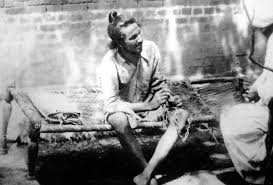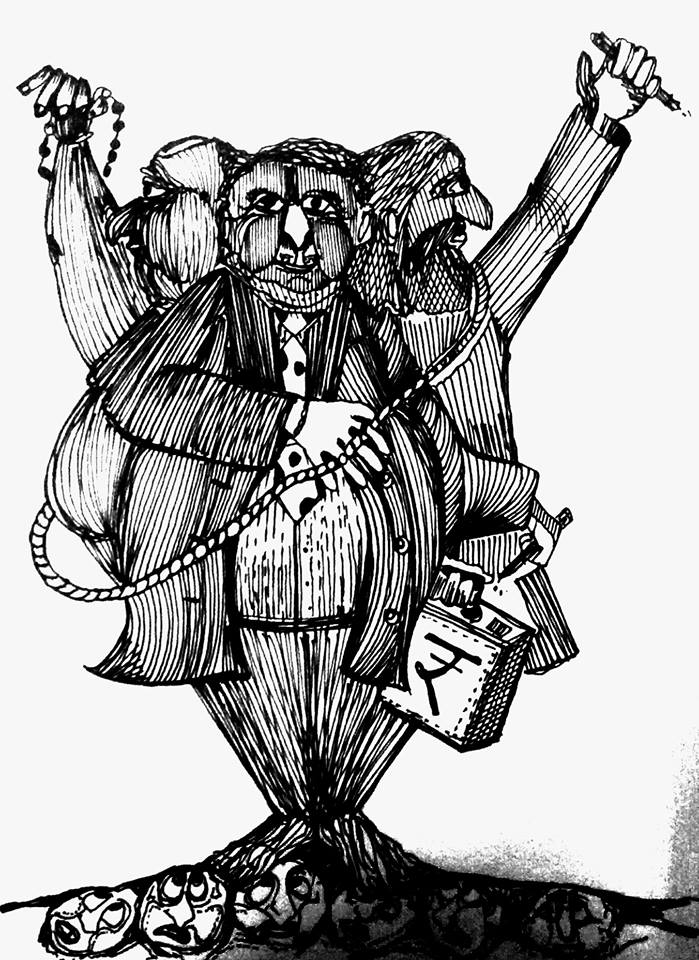Dr. Ratna Panvekar
 Dhamma
Dhamma
The word Dhamma is commonly used in Buddhism and it means the teachings and doctrines of Buddha. These teachings and doctrines describe the nature of things, the way things are, the way they operate. In short it means justice, truth and good behaviour. Dhamma means ethical conduct and righteousness. It is nothing but morality. The Dhamma is one of the Three Jewels of Buddhism in which the practitioners of Buddhism seek refuge, or that upon which one relies for his or her lasting happiness. The Three Jewels of Buddhism are the Buddha- meaning the mind’s perfection of enlightenment; the Dhamma- meaning the teachings and the methods of the Buddha; and the Sangha- meaning the monastic community that provides guidance and support to followers of the Buddha.
Chakra
Dhamma wheel or Dhamma Chakra is commonly known symbol in Buddhism that signifies the teachings of Buddha. It is considered the wheel of transformation and the wheel of law.
Buddha turned the dhamma wheel three times:
Buddha did “Dhammachekkapravatan” i.e. he set the wheel of law into motion. Turning of the wheel signifies a great and revolutionary change with universal consequences. The first turning was the sermon in the deer park, in Sarnath, after the Buddha’s enlightenment. Here, the Buddha explained the Four Noble Truths. He showed the path of freedom and liberation from sufferings. The second turning was the introduction of the perfection of wise teachings on the nature of sunyata (emptiness). The third turning was the introduction of the doctrine of Buddh nature.
Ashoka the Great and influence of Dhamma wheel
Ashoka the Great was the emperor of India’s Maurya Dynasty from 268 to 232 BCE and is chiefly remembered for his remarkable conversion to nonviolence and his merciful reign. He converted from being a brutal conqueror of a vast empire to a benevolent emperor who successfully ruled according to nonviolent principles. The battle of Kalinga that resulted in large-scale destruction of human lives and properties devastated Ashoka mentally though he was victorious. Later on, he embraced Buddhism and became a promoter of non-violence. Buddhist teaching had profound impact on Ashoka. He became a great patron of Buddhism and encouraged its spread, although he never forced it on his subjects. Ashoka erected enormous stone pillars throughout his kingdom, many of which are still standing tall. These pillars contain edicts, some of which encouraged people to practice Buddhist morality and nonviolence. There is typically at least one lion on the top of each pillar, representing Ashoka’s rule. The pillars also are decorated with 24-spoke Dhamma wheels.
Dr Babasaheb Ambedkar rejuvenating and reinventing the Dhamma wheel
At the Yeola conference, on 13th October 1935, in a tremendously emphatic speech, Babasaheb recounted the plight of the depressed classes in all spheres–economic, social, educational and political. Referring to his own personal decision, Babasaheb said that it was unfortunately for him that he was born a Hindu untouchable. It was beyond his power to prevent that, but he declared that it was within his power to refuse to live under ignoble and humiliating conditions. He solemnly assured that he ‘will not die a Hindu’. After this declaration, Babasaheb devoted himself exhaustively to studying the doctrines of all the major world religions and settled for Buddhism for himself and his followers.

Babasaheb’s decision to leave the Hindu fold was a deliberate attempt to liberate the downtrodden from religious slavery. Also, Babasaheb did not agree to stick to an idea or religion which is not beneficial for enhancement of humanity. He considered the foundations of religion to be essential to life and practices of society. He wanted to absorb his community into some powerful community. He exhorted them to welcome that religion which could give the fullest equality of status.
In his article entitled “Buddha and the future of his religion” which he contributed to the Mahabodhi Society Journal, Babasaheb summarised his thoughts on Buddhism as follows:
1. The society must have either the sanction of law or the sanction of morality to hold it together. Without either, society is sure to go to pieces.
2. Religion, if it is to function, must be in accord with reason which is another name for science.
3. It is not enough for religion to consist of a moral code, but its moral code must recognise the fundamental tenets of liberty, equality and fraternity.
4. Religion must not sanctify or ennoble poverty.
According to Babasaheb, Buddhism fulfilled these requirements. He said Buddha’s religion was based on equality, morality, ethics and humanism. Buddha acted as a guide, and the Budhha was satisfied with the role of Margadata (Guide).
Babasaheb focussed the world’s attention on civic, social and political rights and liberties, made untouchability a burning topic of the day, raised it to international importance and gave it global publicity. He struggled hard for emancipation of the downtrodden from religious slavery. He awakened in them a sense of human dignity and self-respect. He infused courage to stand up for justice, equality, liberty and humanism.
The mission of Babasaheb’s life was the establishment of human dignity, development of self-respect among the downtrodden classes and attainment of self-salvation. He was a great teacher who taught the common person to have belief in their potential power, to rouse it, to develop it, and to stand on their own feet. For leading a better and free life, Babasaheb envisaged conversion for the depressed masses a necessity.
Ashok Vijaya Dashami, October 14, 1956, between 9 to 11 am, was the date decided for the conversion. The oldest monk at that time, Mahasthaveer Chandramani, of Kushinara, Dist. Gorkhapur, was invited for the conversion ceremony at Nagpur. In ancient times, Nagas flourished in this city. The great Buddhist scholar, Nagarjun dwelled in Nagpur. Babasaheb preferred Nagpur due to historical reasons and at the request of his followers. The auspicious conversion was held in 14 acres of land, near the Vaccine Institute at Shradhanand Peth, which was turned into an enclosure. At the northen end of it stood a huge dais lined with white cloth and surrounded by a replica of the Sanchi stupa, facing two specially erected pandals on either side–one for men and the other for women. Buddhist flags consisting of blue, red and green stripes fluttered everywhere. All the approaches and streets leading to the place were decorated with buntings. The atmosphere was filled with the praise and chanting of Buddha and Babasaheb.
For this grand historical conversion, Babasaheb dressed up in white silk dhoti and white coat. His wife, Dr Savita Ambedkar (Maisaheb) put on a white saree. The ceremony commenced with a Marathi song in praise of Dr Babasaheb. The vast gathering stood up for a minute and observed silence in the memory of the death anniversary of Babasaheb’s father Ramji Ambedkar. Babasaheb and Maisaheb took the oath of Three Jewels (The three sarans under Buddha, Dhamma and Sangha), Five Precepts and 22 Vows. Babasaheb then gave the oath of Three Jewels, Five Precepts, and 22 Vows to thousands of his followers. The place in Nagpur where this ordination ceremony was conducted is now called, as “Deeksha Bhoomi” and it became the birthplace of the Buddhist movement in India.
Nearly four lakhs of his followers embraced Buddhism. Babasaheb set the wheel of the Buddha’s dhamma in motion once again, spreading the message of his Master to all the corners of the world. It was the greatest religious revolution that India had witnessed in modern times. However, he had seriously warned his people that a great responsibility had fallen on their shoulders in connection with the upholding of Buddhism and if they would not follow rigidly and nobly the principles of Buddhism, it would mean that, the followers had reduced it to a miserable state. No other person under the sun was burdened with such unparalleled responsibility as he was, he concluded. Babasaheb predicted that in the next few years the human values given by Buddha would spread all over the country and fill the mind of every Indian. Babasaheb throughout his life worked for the liberation of suppressed communities in India.
Dhamma Wheel and the Present state
How to make the life of people successful was the motive of Dr Babasaheb Ambedkar and it continues even today. Like his master, the Buddha, did not force his views or thoughts on the masses. He tried to explain the subject in every possible way. Individual progress is what he aimed for. Without sympathy, equality and liberty it is difficult for an individual to be successful. Babasaheb’s view was that an individual should be recognized by society, and ultimately by religion. With individual progress, Babasaheb envisaged the progress of society and the country itself. The individual must have a free mind and to have a free mind he must not be slave of any class or group. One should be mindful and shall be responsible in discharging duties and responsibilities. According to him, free mind is not a slave of usage, customs, traditions, or teachings. A person with free mind has ability to act freely and can utilise full potential for personal developments. Casteism and religious fanaticism has corrupted the mind and morality of the people. The growth and progress of masses at the lower strata had been severely affected due to its ill effects. The path of conversion is only the right path for freedom and ultimately progress of the downtrodden people as analysed by Babasaheb.
It will not be an exaggeration to say that the wheel of the Dhamma set in motion by Babasaheb gets more speed every passing year. However, the Buddhist movement was somewhat hindered by Babasaheb death. It did not receive the immediate mass support from the untouchable population. Division and lack of direction among the leaders of the Ambedkarite movement have been an additional impediment. Though the pace is reduced, it has not stopped and in future one may expect acceleration of this movement. That enormous interest in Buddhism by the depressed class has been observed in other Indian states is a good sign for humankind and humanity.
At present time Ashok Vijaya Dashmi is celebrated as a liberation day. Deekshabhoomi has been a great source of inspiration for millions and it will continue to inspire people for ages. A large number of Buddhists and Bahujans from across the country gather here every year to remember their emancipator and to cherish the path of revolution. It is because of Babasaheb one can learn and live a dignified life. This place has attained the status of a holy place where Babasaheb broke the shackles of the caste system and gave a new direction and a new life to the depressed people. Since then it has witnessed many mass conversions and helped several oppressed people to gain freedom from caste, class or supreme power mental slavery with focus on human relations, human values, scientific temper and overall development.
We are so indebted to the greatest man who has rendered life-long service to the country. I am so grateful to Babasaheb that he made us to walk on the path of great Dhamma. Happy 63rd Dhamma Chakrapravartan Din to all.
~~~
Dr. Ratna Panvekar (Ph.D. in Physics) is an Assistant Professor in Physics at MH Saboo Siddik College of Engineering, Mumbai. Besides teaching, she is involved in Singing and writing articles, songs and poems. She is an Amedkarite-Buddhist.










